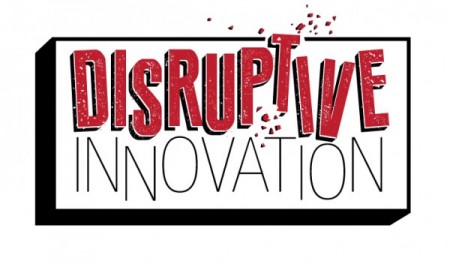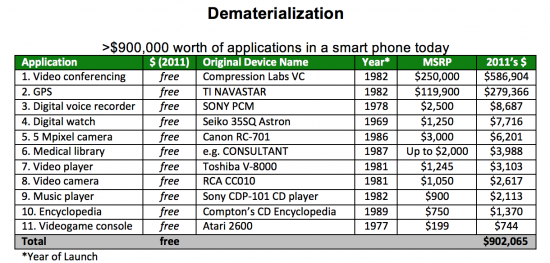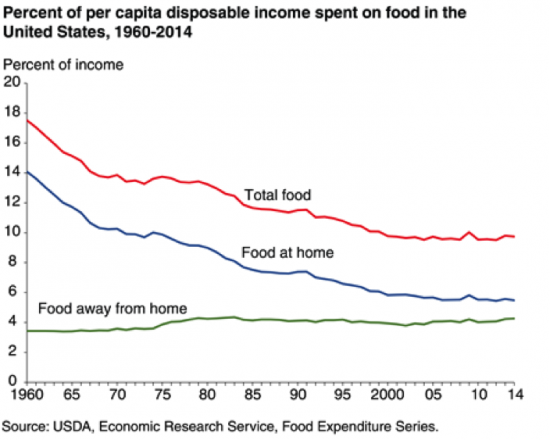July 18, 2016 – In the latest email I received from Peter Diamandis, founder of the Ansari XPrize he talks about the rapid demonetization of the cost of living. What does that mean? Diamandis continues stating “it’s getting cheaper and cheaper to meet our basic needs.” Do you believe this is true? Well read on as he describes a rapidly changing view of how we spend money and how we will in the near future.
———-
Spending habits around the world tell a pretty consistent story. We tend to spend money on many of the same basic products and services. Take a look at how consumers spent their money in three large economies: The United States, China, and India.
In the U.S., in 2011, 33% of the average American’s income was spent on housing, followed by 16% spent on transportation, 12% spent on food, 6% on healthcare, and 5% on entertainment. In other words, more than 75% of Americans’ expenditures come from those basic requirements.
In China, per a recent Goldman Sachs Investment Research report, there is a similar breakdown — food, housing, mobility, and well-being make up the majority of Chinese family expenditures. Interestingly, in China, consumers care significantly more about looking good and eating better (and less about having more fun) than in the United States with nearly half of consumer income going to clothes and food.
In India, with a population of 1.2 billion people, expenditures on food, transportation, and miscellaneous goods and services are most prominent. Rent or housing and healthcare represent a smaller percentage.
These differences are likely cultural but overall, you see that the majority of expenditures cover these seven categories:
- Transportation
- Food
- Healthcare
- Housing
- Energy
- Education
- Entertainment
Now, imagine what would happen if the cost of these items plummeted.
Here’s how…
Rapid Demonetization – What It Means
I define “demonetization” as the means by which technology takes a product or service previously expensive and makes it substantially cheaper, or potentially free. It literally means removing money from the equation. Here are some industry examples:
In the Kodak years, photography was expensive. You paid for the camera, for the film, for developing the film, and so on. Today, during the Megapixel era, the camera is free in your phone, no film, no developing. Completely demonetized.
In years past, collecting obscure data was hard, expensive in time if you did it yourself, or expensive in money if you hired researchers. Today in the age of Google collecting data has become free and its quality is 1000 times better. Access to information, data and research, like photography, is fully demonetized.
Consider live video and phone calls. Skype, Google Hangouts, and others have completely demonetized both.
The list goes on:
- Craigslist has demonetized the classifieds
- iTunes has demonetized the music industry
- Uber has demonetized transportation
- AirBnb has demonetized hotels
- Amazon has demonetized bookstores
Demonetizing More Than $900,000 U.S. Worth of Stuff We Take for Granted
In the back of my book Abundance (Page 289 of the recent edition), I provide a chart showing how we’ve demonetized $900,000 worth of products and services that you might have purchased between 1969 and 1989.
People with a smartphone today can access tools that cost thousands a few decades ago. Twenty years ago most well-off American citizens owned a camera, a video camera, a CD player, a stereo, a video game console, a cellphone, a watch, an alarm clock, a set of encyclopedias, a world atlas, a Thomas travel guide, and a whole bunch of other assets that easily add up to more than $900,000. Today, all of these come for free with your smartphone. What is strange is that we don’t value these things when they become free. We just expect them.
So now, let’s look at the top seven categories described above, where people globally are spending their cash today, and how these things are likely to become demonetized over the next two decades.
Transportation: The trillion dollar automotive market is already being demonetized by startups like Uber. And when Uber rolls out fully autonomous services, the cost of transportation will plummet even further.Think about all of the related costs that will disappear: auto insurance, auto repairs, parking, fuel, parking tickets… The overall cost of “getting around” will be 5 to 10 times cheaper when compared to owning a car.This is the future of “car as a service” with even the poorest of us being chauffeured around.
Food: As I noted in Abundance, the cost of food has dropped thirteenfold over the past century. That reduction will continue (see chart below). Additional cost reductions will occur as we learn to produce foods locally and efficiently through vertical farming (note that 70% of food’s final retail price comes from transportation, storage and handling). Also, as we make genetic and biological advances, we will learn how to increase agricultural yields per square meter.
Healthcare: We can define healthcare services in four major categories:
- Diagnostics: Artificial intelligence (AI) is already demonstrating its ability to diagnose cancer patients better than the best doctors, reviewing image data pathology, and genomics to draw conclusions. AI can sort through gigabytes of phenotypic data something no doctor can do easily. And AI does it for the cost of the electricity that runs the computing technology upon which the AI resides.
- Intervention/Surgery: Today surgical robotics is becoming more common. In the near future our best surgeons will be robots. They’ll be able to move with precision and image a surgical field in high magnification. Each robotic surgeon will call upon data from millions of previous robotic surgeries, outperforming their most experienced human counterpart. Again, the cost of the service and delivery will be astronomically less than current surgical procedures.
- Chronic/Eldercare: Taking care of the aging or chronically ill will be done most efficiently using robot care providers.
- Medicines: AI will help to make the discovery of new medications and their manufacture more efficient. And perhaps in the near future, home 3D printers will be capable of assembling custom designed medications based on our smartphone apps assessment of our health. Also worth noting is the plummeting price of genomics as seen in the graph below. With accurate and inexpensive genome sequencing we will be able to predict which diseases we are most likely to develop, and what medications we will need for customized treatment.
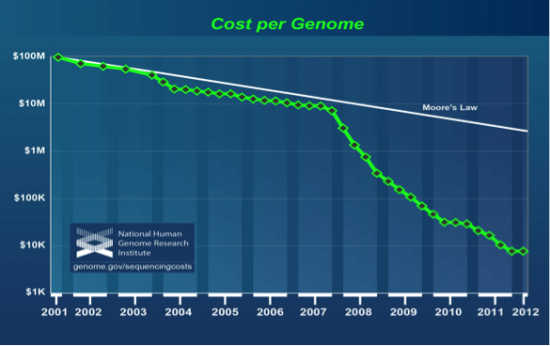 The plummeting cost to sequence the human genome (Source: NHGRI)
The plummeting cost to sequence the human genome (Source: NHGRI)
Housing: Think about what drives high housing costs. Why does a single-family apartment in Manhattan cost $10 million, while the same square footage on the outskirts of St. Louis can be purchased for $100,000? Location. Location. Location. People flock to high-density, desired areas, near their jobs and near entertainment. This is the market demand that drives up the price. But housing will become demonetized for two reasons. The first is because of two key technologies which make proximity of a home to your job irrelevant, meaning you can live anywhere, specifically where the real estate is cheap. These technologies are:
- Autonomous Cars: If your commute time can become time to read, relax, sleep, watch a movie, have a meeting, will it matter if takes 90 minutes?
- Virtual Reality: What happens when your workplace is actually a virtual office where coworkers are avatars? When you no longer need to commute at all, you wake up, plug into your virtual workspace, and telecommute from the farm or from the island of Lesbos.
The second group of drivers includes robotics and 3D printing. Both will demonetize the cost of building structures. Today a number of startups are exploring how 3D printed structures and buildings can dramatically reduce construction costs and the time to build. For example, a company out of China, Winsun, has recently 3D printed an entire apartment building as seen below.
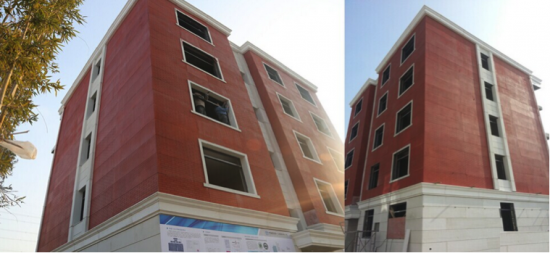 6-storey building 3D printed by Winsun
6-storey building 3D printed by Winsun
Energy: Five thousand times more energy hits the surface of the Earth from the Sun in an hour than all the energy we humans use in a year. Solar is abundant worldwide, and better yet, the poorest countries on Earth are the sunniest. Today, the cost of solar energy has dropped to approximately $0.03 per kilowatt hour. This cost will continue to decline with further material science advances, for example, replacing silicon with perovskite, making solar panels even more efficient.
Education: It is already being demonetized in many respects, as much of the information learned in classrooms can be found online, for free. Coursera, Khan Academy, and schools like Harvard, MIT and Stanford have put thousands of hours of high-quality instruction online, available to everyone on the planet with connection to the Internet. And this is just the beginning. Soon the best professors in the world will AIs, able to know the exact abilities, needs, desires and knowledge of a student and to teach them exactly what they need to know in the best fashion at the perfect rate. Accordingly, the child of a billionaire or the child of a pauper will have access to the same (best) education delivered by such an AI, effectively for free.
Entertainment: In the past video and gaming historically required significant purchases in equipment and services. Today, with the advent of music streaming services, YouTube, Netflix, the iPhone and Google App stores, we’re seeing an explosion of available entertainment types and selections while the cost continues to rapidly decline. YouTube today has more than a billion users, almost one-third of all people on the Internet. Every day, people watch hundreds of millions of hours on YouTube generating billions of views.
———
Is the world described by Diamandis no more than a technological Utopia, a pipe dream? Or is much of what he presents going to come to fruition? Your thoughts and predictions are welcomed.

